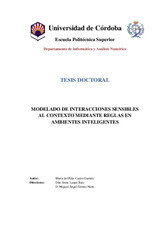Modelado de interacciones sensibles al contexto mediante reglas en ambientes inteligentes
Autor
Castro Garrido, María del Pilar
Director/es
Luque Ruiz, IreneGómez-Nieto, Miguel Ángel
Editor
Universidad de Córdoba, Servicio de PublicacionesFecha
2013Materia
Inteligencia Ambiental (Aml)OBCAS (Ontology-Based Context Awareness System)
Modelos de interacción
Dispositivos NFC
Entornos inteligentes
AGATHA
Sistemas de alarma
Aplicaciones informáticas
METS:
Mostrar el registro METSPREMIS:
Mostrar el registro PREMISMetadatos
Mostrar el registro completo del ítemResumen
La Inteligencia Ambiental (AmI) propone la creación de entornos o ambientes
inteligentes que se adapten a las necesidades, gustos e intereses de la gente que vive en
ellos. Su principal objetivo es crear espacios constituidos por interfaces inteligentes e
intuitivas integradas en objetos cotidianos con los que el usuario interacciona de forma
natural y sin esfuerzo. Estas interfaces poseen capacidad para reconocer la presencia de
diferentes usuarios, y modificar su comportamiento en función de la identidad de dicho
usuario, sus necesidades y las características del contexto o entorno donde se
encuentren.
Dentro del campo de AmI, esta tesis se centra en el modelado de las interacciones
que tienen lugar en este tipo de entornos. Para ello se hace necesario el estudio de un
modelo, basado en una relación unívoca Tag-Objeto, en el que los objetos puedan tener
asociadas más de una característica (en un único Tag), siendo el usuario el que decida
con cuál de ellas interactúa a través de su terminal, teniendo en cuenta también los
recursos disponibles en él y el historial de interacciones previas.
Un entorno inteligente, además de contener objetos aumentados con Tag RFID,
estará ubicado en una localización específica, es decir, en una zona geográfica bien
definida. Esta característica hace posible otro tipo de interacciones, aquellas basadas en
la localización. Así, un entorno o espacio inteligente no solamente proporcionará
servicios al usuario cuando interaccione con alguno de los objetos que tiene definidos,
sino que también es capaz de ofrecer otros servicios al usuario basándose simplemente
en su localización.
OBCAS propone una solución para el modelado de interacciones sensibles al
contexto mediante reglas en ambientes inteligentes en la que las reglas no van a estar
definidas de forma independiente, sino que van a formar parte del comportamiento de
un conjunto de agentes. OBCAS está compuesto por un sistema multi-agente que tendrá
un componente en el lado servidor y otro en el lado móvil. Todos los agentes que
componen este sistema se comunican utilizando el protocolo FIPA y utilizando en el
lenguaje de contenido el modelo ontológico definido en OBCAS-Ontology (Kernel). El
kernel es una ontología cuya función es la representación e integración de los diferentes
modelos (ontologías) y sus relaciones, de forma que representen a todos los elementos
o artefactos que participan en la hipótesis para el modelado de escenarios y el
desarrollo de aplicaciones NFC ubicuas y sensibles al contexto.
Este sistema puede ser utilizado en cualquier aplicación en la que se realicen
interacciones sensibles al contexto, y para verificar su eficacia se ha desarrollado
AGATHA, un sistema de alarmas que monitoriza el cumplimiento de un conjunto de
restricciones que están asociadas a ciertos usuarios. Esta aplicación ha demostrado la
rapidez con la que el sistema es capaz de reaccionar y adaptarse al contexto del usuario,
evitando por ejemplo que un agresor se acerque a una víctima o que un anciano se
pierda. Ambient Intelligence (AmI) proposes the creation of smart environments able to
adapt to the needs, tastes and interests of the people living in them. Its main objective is
to create spaces constituted by intelligent and intuitive interfaces embedded in everyday
objects with which the user interacts naturally and effortlessly. These interfaces have
the capacity to recognize the presence of different users, and modify their behavior
depending on the user's identity, needs and characteristics of the context or
environment.
Within the field of AmI, this thesis is focused on the modeling of the interactions
that take place in these environments. In order to do so, it is necessary to study a model
based on an univocal Tag-Object relationship, where objects can have associated more
than one characteristic (to one tag), and the user decides which one to interact with
through its terminal. The resources available in the terminal, and the history of previous
interactions are also considered.
A smart environment contains objects augmented with RFID Tag, and it is located
in a specific location, i.e. a well-defined geographical area. This feature makes possible
other interactions, those based on location. Hence, a space or smart environment not
only provide intelligent services to the user when interacting with any of the objects
that have been defined, but it is also able to provide the user with other services based
simply on its location.
OBCAS proposes a solution for modeling context-sensitive interactions in smart
environments through rules, in which the rules will not be defined independently, but
they will be part of the behavior of a set of agents. OBCAS comprises a multi-agent
system that will have a component on the server side and another one on the mobile
side. All agents making up the system use the FIPA protocol, and the ontological
model OBCAS-Ontology (Kernel). The Kernel is an ontology whose function is the
representation and integration of the different models (ontologies) and their
relationships, so representing all the elements or artifacts involved in the scenario
modeling and the development of ubiquitous and context-awareness NFC application.
This system can be used in any application with context-aware interactions. In
order to verify its efficacy has been developed AGATHA, an alarm system which
monitors the performance of a set of constraints that are associated with certain users.
This application has demonstrated the speed with which the system is able to react and
adapt to the context of the user, e.g. preventing the approaching of an attacker to a
victim.

